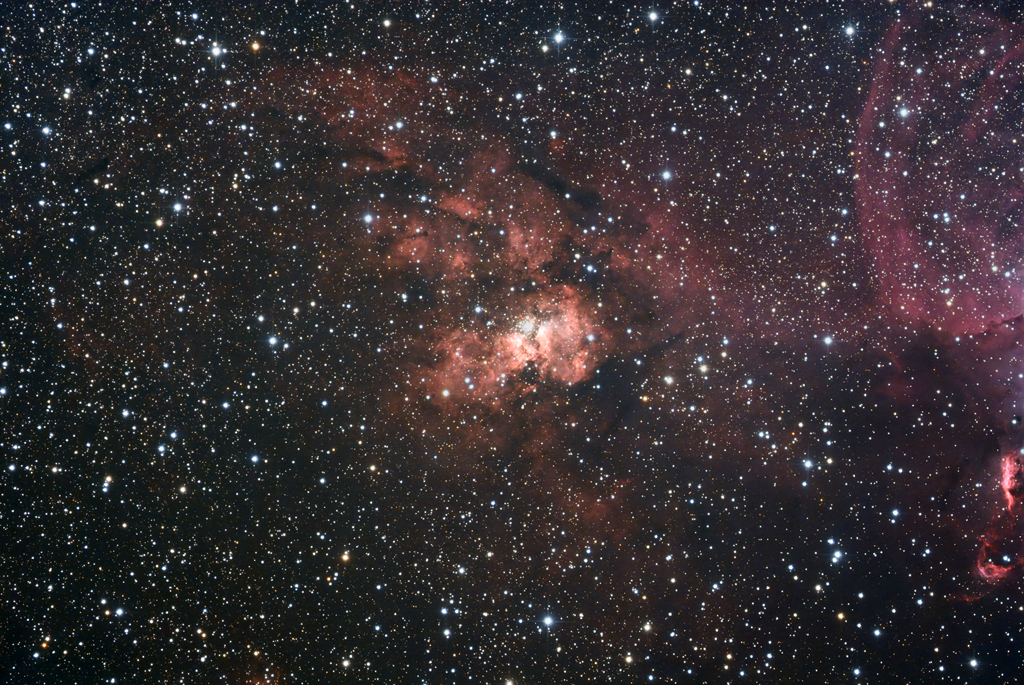 |
CHAMÄLEON + ONJALA OBSERVATORY DeepSky | SITEMAP HOME CHAMÄLEON |
|
 |
|||
| « zurück zur Startseite
galaktische Nebel « back to home galactic nebula |
Großes Bild laden - load large
image 2048 x
1400 Pixel Aufnahmedaten Image data |
NGC 3603 + RCW 57 - an open star cluster and H-II emission in the constellation Carina

NGC 3603 ist auf den ersten Blick ein ziemlich unscheinbarer kleiner offener Sternhaufen im Sternbild Carina, der inmitten einer rötlichen H-II Nebelregion liegt, die auch als RCW 57 katalogisiert ist. Er hat nur einen scheinbaren Durchmesser von 4 Bogenminuten, beinhaltet etwa 40 Sterne und wird nach Trumpler der Klasse I 1 p n zugeordnet.
Betrachtet man seine Entfernung zum Sonnensystem von etwa 22.000 Lichtjahren ergibt sich ein zweiter Blick auf den Sternhaufen. Denn da zeigt sich, dass NGC 3603 einer der größten offenen Sternhaufen in unser Galaxie ist, der zudem die höchste Anzahl an Wolf Rayet Sternen und zudem - mit ca. 110 Sonnenmassen - eines der massereichsten Doppelsternsystem enthält.
Das Alter der massereichen Sterne in NGC 3603 wird nur auf wenige Millionen Jahre geschätzt. Die Region wurde am 14. März 1834 vom britischen Astronomen John Herschel entdeckt. Weitere Information zu NGC 3603 gibt die ESO hier. Und hier finden Sie ein Bild von NGC 3603, aufgenommen mit dem Weltraumteleskop Hubble.
Object description
NGC 3603 is at first sight a rather inconspicuous small open star cluster in the constellation Carina, located in the middle of a reddish H-II nebular region, also cataloged as RCW 57. It has an apparent diameter of only 4 arcminutes, contains about 40 stars, and is classified as class I 1 p n by Trumpler.
Considering its distance to the solar system of about 22,000 light-years, a second view of the star cluster arises. It shows that NGC 3603 is one of the largest open clusters in our galaxy, which also contains the highest number of Wolf Rayet stars and - with about 110 solar masses - one of the most massive double star systems.
The age of the massive stars in NGC 3603 is estimated to be only a few million years. The region was discovered by British astronomer John Herschel on March 14, 1834. More information about NGC 3603 is available from ESO here. And here is an image of NGC 3603 taken with the Hubble Space Telescope.
NGC 3603 + RCW 57 - an open star cluster and H-II emission in the constellation Carina
Image data
23.05.2022 - 23 x 300 s, QHY ALccd 12 (cooled)
Telescope: PlaneWave CDK 12.5" Astrograph + 0.8x Reducer at f = 2030 mmm
Location: Chamäleon Observatory, Onjala Lodge, Namibia
Image acquisition and processing: DeepSkyStacker, PixInsight + Photoshop
 |
 |
 |
 |
 |
 |
 |
| Sonne | Mond | Sonnensystem | DeepSky | Weitwinkel | Verschiedenes | Spez. Projekte |